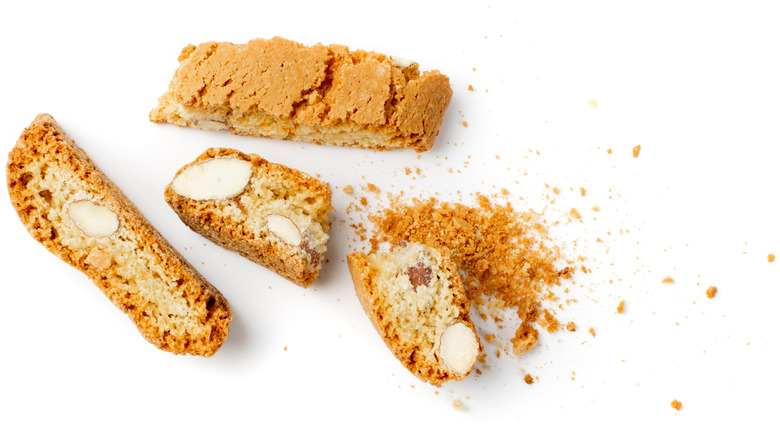American Biscotti Actually Have A Different Name In Italy
It should come as no real surprise that the same word can have different meanings in separate languages. However, it is a bit odd that the English "biscotti" — a phrase clearly taken from Italian — has a somewhat unique definition in the United States compared to Italy. In the good old U.S. of A., "biscotti" refers to "a crisp cookie or biscuit of Italian origin that is flavored usually with anise and [hazelnuts] or almonds." However, for the Italians, in their homeland, "biscotti" directly translates to "cookies," a catch-all term for that broad category of pastry.
Originally, the Latin word "biscoctus," the ancient ancestor of "biscotti", was used to designate something as being twice cooked or baked. So, in a sense, Americans are truly the ones being more authentic in their terminology. What then do they call crisps flavored with spices, fruits, and nuts in that boot-shaped nation on the other side of the Atlantic?
Biscotti are cantucci in Italy
"Cantucci" is the word in Italian for crackly and crumbly confections that are firm enough to be dipped in lattes, espresso, or coffee without disintegrating. While this distinction may seem odd to Americans, it makes sense when you consider logistics. Just saying "biscotti" a.k.a. "cookies" wouldn't pin much down in Italy, so a new word was chosen. The term "cantucci" is derived from "cantuccio," which is what Italians call a nook or the end slice of a bread loaf — appropriate, considering cantucci is little and crusty (as in, bread crust). Maybe the United States should get on the same page and also start saying "cantucci?"
Well, that actually might be getting too specific. Cantucci come with their own regional traditions that make them stand apart slightly from the Americanized biscotti. For example, cantucci almost always feature almonds as well as fruity essences in the form of orange juice, oil, or zest. However, on the whole, cantucci are less sweet than biscotti, so Italians even regularly dunk them in vin santo, a dessert wine made from partially raisinated grapes matured under oxidative conditions. The history behind this cultural contrast is fascinating. Let's break it apart!
Cantucci and biscotti diverged centuries ago
Something similar to biscotti and cantucci was made to feed soldiers in Ancient Rome. When the empire fell, the fortifying snack was practically forgotten — that is, until the 14th century. That's when bakeries in the Tuscan city of Prato started using local almonds to make Biscotti di Prato (borrowing from Latin for the first part of its name). These biscuits were mold-resistant, meaning they could last quite a while. So, when Christopher Columbus sailed the ocean blue, he took Biscotti di Prato with him as sea rations. Apparently, in the New World, the "di Prato" part of the moniker was dropped, presumably for convenience.
Meanwhile, Biscotti di Prato stayed in Italy and — likely because cities other than Prato started producing this treat — "cantucci" replaced "Biscotti di Prato." Vin santo originated from the same general time and place as biscotti, so the two have long been served together at the end of a meal when entertaining guests. Unlike biscotti, however, that wine doesn't seem to have caught on in a big way in the United States. Thus, biscotti typically goes with coffee-based drinks, while cantucci additionally pairs with vin santo. Sometimes, that's just how the biscotti crumbles.


